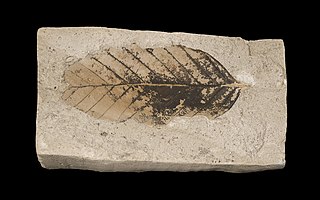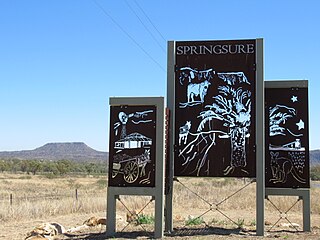Zieria inexpectata is a plant in the citrus family Rutaceae and endemic to south-eastern Queensland. It is a small, compact shrub with erect, wiry branches, three-part leaves and groups of up to twelve white flowers, the groups longer than the leaves and the flowers with four petals and four stamens. It was unexpectedly discovered by the authors during a field trip and its discovery led to a paper describing the zierias of Queensland, including sixteen new species.
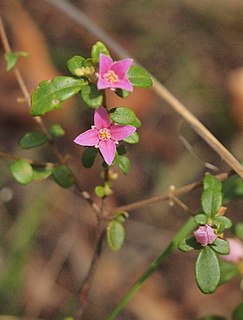
Boronia obovata is a plant in the citrus family Rutaceae and is endemic to the Blackdown Tableland National Park in Queensland, Australia. It is an erect shrub with many branches, leaves usually with three leaflets, and pink, four-petalled flowers.
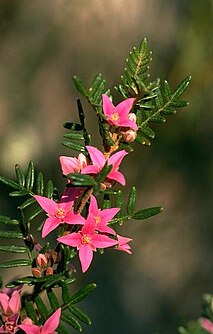
Boronia amabilis, commonly known as Wyberba boronia, is a plant in the citrus family, Rutaceae and is endemic to a small area in southern Queensland. It is an erect shrub with many branches, pinnate leaves with hairy lower surfaces and pink, four-petalled flowers.

Boronia anethifolia, commonly known as narrow-leaved boronia, is a plant in the citrus family, Rutaceae and is endemic to eastern Australia. It is an erect shrub with four-angled branches, bipinnate leaves and white, sometimes pale pink, four-petalled flowers.
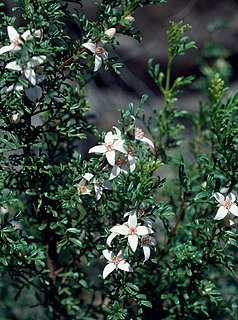
Boronia eriantha is a plant in the citrus family Rutaceae and is endemic to central Queensland, Australia. It is an erect shrub with many branches, leaves with up to nine leaflets, and white and red, four-petalled flowers.

Boronia forsteri is a plant in the citrus family Rutaceae and is endemic to mountain ranges in central Queensland, Australia. It is an erect shrub with many branches, simple leaves with a densely hairy, pale underside, and pink, four-petalled flowers.
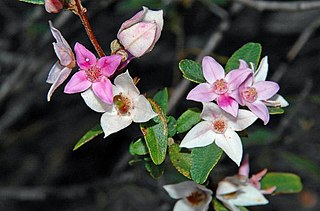
Boronia grimshawii is a plant in the citrus family Rutaceae and is endemic to mountain ranges in central Queensland, Australia. It is an erect shrub with many branches, simple leaves with a densely hairy, pale underside, and pink, four-petalled flowers.

Boronia odorata is a plant in the citrus family Rutaceae and is endemic to the central highlands of Queensland, Australia. It is an erect shrub with many branches, mostly simple leaves and pink to white, four-petalled flowers.

Boronia pilosa, commonly known as the hairy boronia, is a plant in the citrus family Rutaceae and is endemic to south-eastern Australia. It is an erect, woody shrub with hairy branches, pinnate, sometimes hairy leaves and groups of up to ten white to pink, four petalled flowers.

Boronia rivularis, commonly known as the Wide Bay boronia, is a plant in the citrus family Rutaceae and is endemic to the Wide Bay–Burnett area of eastern Queensland. It is an erect, woody shrub with pinnate leaves and white to pink, four-petalled flowers.

Boronia bella is a plant in the citrus family Rutaceae and is endemic to a mountain range near Many Peaks Queensland, Australia. It is an erect shrub with many branches, simple leaves and four-petalled flowers.
Boronia citrata, commonly known as lemon boronia, is a plant in the citrus family, Rutaceae and is endemic to Victoria. It is an erect, woody shrub with pinnate, strongly lemon-scented leaves and pale pink to rosy pink, four-petalled flowers arranged in groups of up to five.

Boronia excelsa is a plant in the citrus family Rutaceae and is endemic to a small area in Far North Queensland. It is an erect shrub with woolly-hairy branches, simple, stalkless, more or less hairless leaves, and pink to white, four-petalled flowers.

Boronia filicifolia is a plant in the citrus family, Rutaceae and is endemic to the far north-west of Australia. It is an erect or sprawling shrub with many branches, pinnate leaves with up to 55 leaflets and white to pink flowers with the sepals a similar length to the petals.
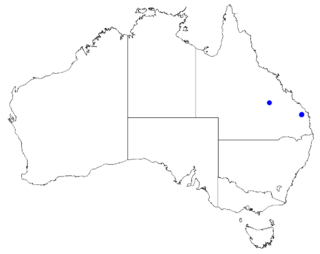
Boronia foetida is a plant in the citrus family Rutaceae and is endemic to a small area in Queensland. It is an erect shrub with hairy branches, simple leaves and pink to white, four-petalled flowers usually arranged singly in leaf axils. The leaves have an unpleasant smell when crushed.
Boronia hoipolloi is a plant in the citrus family Rutaceae and is endemic to a small area in Queensland. It is an erect or pendulous shrub with pinnate leaves and pink, four-petalled flowers. It is only known from a few collections near Mount Isa.

Boronia jensziae, commonly known as Andy Jensz's boronia or Hinchinbrook boronia, is a plant in the citrus family Rutaceae and is endemic to Hinchinbrook Island in Queensland. It is an erect, densely branched shrub with simple leaves and pink to white, four-petalled flowers usually arranged singly in leaf axils.
Boronia minutipinna is a plant in the citrus family Rutaceae and is endemic to a small area in the Kimberley region of Western Australia. It is an erect shrub with many branches, hairy stems and leaves, pinnate leaves and white to pink, four-petalled flowers with the sepals longer and wider than the petals.
Boronia montimulliganensis is a plant in the citrus family Rutaceae and is endemic to a single mountain in Queensland. It is an erect, woody shrub with pinnate or bipinnate leaves and white, four-petalled flowers usually arranged singly in leaf axils.
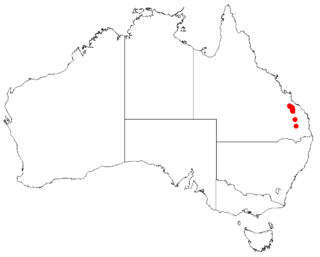
Boronia palasepala is a plant in the citrus family Rutaceae and is endemic to a small part of Queensland, Australia. It is an erect, rounded shrub with many branches, simple leaves and pink to white, four-petalled flowers.








